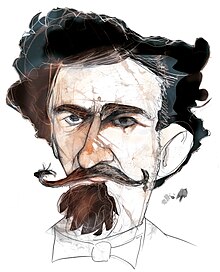Ramon Verea
Ramón Silvestre Verea Garcia (born December 1, 1833 in Esmoris in San Miguel de Curantes in Pontevedra , † February 6, 1899 in Buenos Aires ) was a Spanish journalist, known as a designer of calculating machines .
Verea was originally supposed to be a priest and studied at the seminary of Santiago de Compostela . After six years of study, he decided against the priesthood and went to Cuba in 1855 . He was a teacher, writer and journalist there. When he lived in Colón , he invented a machine for folding newspapers, the patent of which he later sold in New York. In 1865 he went to New York . He was initially a journalist, but retained his technical interest and was in Havana in the late 1860s and early 1870s , where he worked as a representative for imported modern machines and equipment. In 1875 he was back in New York, where he continued his trading agency and in 1877 became director of the El Cronista newspaper. In 1879 he visited his homeland again. In 1882 he founded a printing company in New York and in 1884 he founded the magazine El Progreso. Dissatisfied with the US intervention in Cuba, he left the country in 1895 and went to Guatemala, where he published several books. In 1897 he went to Buenos Aires, where he also founded a magazine and worked as a journalist.
In order to show in his own words that Spaniards were also capable of inventions, he built a calculating machine in 1878 and applied for a patent (granted in 1878). The idea may also have occurred to him when he had to do calculations for his part-time changing job (gold, Spanish foreign exchange). It was a multiplication body calculating machine, the second such machine after Edward Barbours (1841-1925) in Boston, who received a patent on it in 1872. In the 19th century there were two successors with machines of this type, the French Léon Bollée and the Swiss Otto Steiger , who founded one of the first commercially successful calculating machine series based on this principle.
The prototype of his machine, which he sent to the patent office, is in the collection of Thomas J. Watson at IBM . He built a second machine, which he exhibited at an inventors' exhibition in Cuba in 1878 and won a prize with it. He didn't build any more machines and then turned to other things.
Web links
| personal data | |
|---|---|
| SURNAME | Verea, Ramón |
| ALTERNATIVE NAMES | Verea Garcia, Ramón Silvestre |
| BRIEF DESCRIPTION | Spanish calculating machine designer |
| DATE OF BIRTH | December 1, 1833 |
| PLACE OF BIRTH | Curantes |
| DATE OF DEATH | February 6, 1899 |
| Place of death | Buenos Aires |
